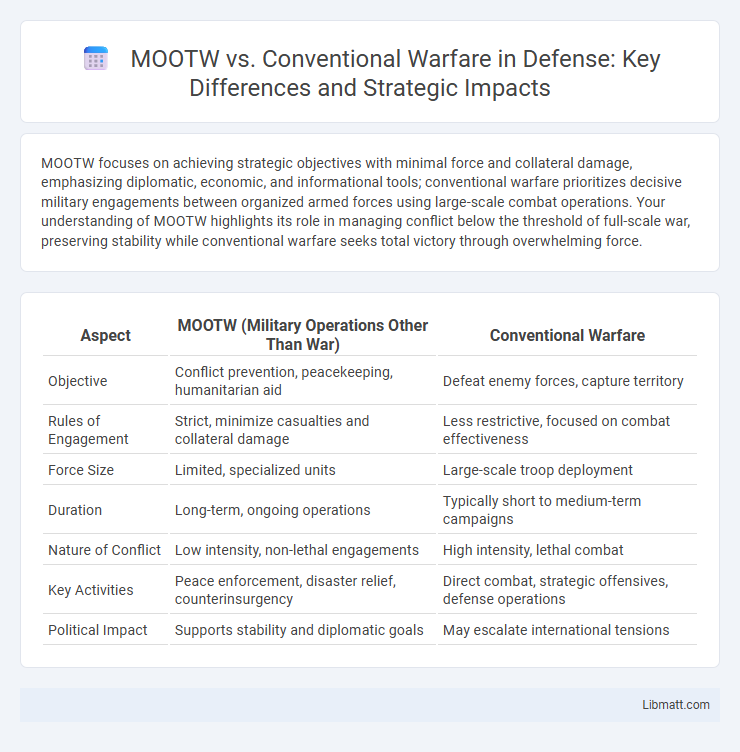MOOTW focuses on achieving strategic objectives with minimal force and collateral damage, emphasizing diplomatic, economic, and informational tools; conventional warfare prioritizes decisive military engagements between organized armed forces using large-scale combat operations. Your understanding of MOOTW highlights its role in managing conflict below the threshold of full-scale war, preserving stability while conventional warfare seeks total victory through overwhelming force.
Table of Comparison
| Aspect | MOOTW (Military Operations Other Than War) | Conventional Warfare |
|---|---|---|
| Objective | Conflict prevention, peacekeeping, humanitarian aid | Defeat enemy forces, capture territory |
| Rules of Engagement | Strict, minimize casualties and collateral damage | Less restrictive, focused on combat effectiveness |
| Force Size | Limited, specialized units | Large-scale troop deployment |
| Duration | Long-term, ongoing operations | Typically short to medium-term campaigns |
| Nature of Conflict | Low intensity, non-lethal engagements | High intensity, lethal combat |
| Key Activities | Peace enforcement, disaster relief, counterinsurgency | Direct combat, strategic offensives, defense operations |
| Political Impact | Supports stability and diplomatic goals | May escalate international tensions |
Introduction to MOOTW and Conventional Warfare
Military Operations Other Than War (MOOTW) focus on achieving strategic objectives without full-scale combat, emphasizing peacekeeping, humanitarian aid, and conflict prevention. Conventional warfare involves direct, large-scale combat between organized military forces to decisively defeat an adversary using traditional weapons and tactics. Understanding the differences helps you appreciate how modern military strategies adapt to diverse global challenges beyond traditional battlefields.
Defining MOOTW: Objectives and Scope
Military Operations Other Than War (MOOTW) encompass a range of non-combat missions like peacekeeping, disaster relief, and humanitarian assistance, aimed at stabilizing regions and supporting civil authorities. Unlike conventional warfare, which primarily focuses on defeating enemy forces through direct combat, MOOTW prioritizes conflict prevention, crisis management, and maintaining order without large-scale violence. You must understand that MOOTW's objectives are broader, emphasizing political and social stability rather than territorial conquest or outright military victory.
Understanding Conventional Warfare: Principles and Practices
Conventional warfare emphasizes large-scale military engagements using organized armed forces and established combat strategies to achieve decisive victories. It relies on principles such as mass, maneuver, and combined arms tactics, often involving infantry, armor, artillery, and air support in coordinated operations. The practice of conventional warfare prioritizes territorial control, force superiority, and direct confrontation to systematically defeat an adversary's military capabilities.
Key Differences Between MOOTW and Conventional Warfare
Military Operations Other Than War (MOOTW) prioritize conflict prevention, peacekeeping, and humanitarian assistance, contrasting with conventional warfare's focus on large-scale armed combat aimed at decisive victories. MOOTW often involves limited force application, rules of engagement emphasizing minimal casualties, and close cooperation with civilian agencies, whereas conventional warfare employs overwhelming firepower and strategic maneuvers to defeat enemy forces. Your understanding of these key differences is essential for adapting military strategy to complex, non-traditional conflict environments.
Strategic Goals: Peacekeeping vs. Combat Operations
Military Operations Other Than War (MOOTW) prioritize strategic goals centered on peacekeeping, conflict prevention, and stability enhancement, minimizing hostility and collateral damage. Conventional warfare focuses on defeating enemy forces through decisive combat operations aimed at territorial control and political domination. Your understanding of these differing goals helps clarify the distinct approaches and measures used in MOOTW compared to traditional wartime strategies.
Operational Environments: Complexity and Dynamics
MOOTW (Military Operations Other Than War) occur in complex, multidimensional operational environments characterized by political sensitivities, irregular threats, and civilian interactions requiring adaptable and nuanced strategies. Conventional warfare environments typically involve structured battlefields with clear frontlines and identifiable enemy forces, focusing on decisive combat operations and territorial control. Your success in MOOTW depends on understanding the fluid dynamics and cultural contexts that differ significantly from the more rigid and predictable conventional warfare scenarios.
Use of Force and Rules of Engagement
MOOTW (Military Operations Other Than War) emphasize limited use of force with strict adherence to rules of engagement designed to minimize collateral damage and protect civilian lives, contrasting with conventional warfare's broader application of force aimed at defeating enemy combatants. MOOTW operations prioritize restraint and proportionality, often involving peacekeeping, humanitarian assistance, and conflict prevention missions under international mandates. Understanding these distinctions is crucial for aligning Your tactical decisions with legal and ethical standards while achieving strategic objectives.
Role of International and Non-State Actors
Military Operations Other Than War (MOOTW) prioritize cooperation with international organizations like the United Nations and non-state actors such as NGOs to achieve humanitarian and peacekeeping goals. Conventional warfare often centers on state actors and traditional military engagements, with limited involvement of non-state entities. Your understanding of MOOTW highlights the critical role of diplomacy and multilateral efforts in today's complex conflict environments.
Challenges and Limitations in Execution
MOOTW (Military Operations Other Than War) face challenges such as complex rules of engagement and the necessity for precise, non-lethal force application, which contrast with the more straightforward objectives in conventional warfare. Limited resources and the need for extensive inter-agency coordination complicate MOOTW execution, whereas conventional warfare primarily relies on direct combat capabilities and clear command structures. Furthermore, MOOTW demand heightened cultural sensitivity and intelligence integration to avoid escalation, which is less emphasized in traditional, kinetic battle scenarios.
Future Trends: The Evolving Nature of Conflict
Future trends in MOOTW (Military Operations Other Than War) emphasize increased reliance on cyber warfare, information operations, and multinational peacekeeping efforts to address asymmetric threats and complex geopolitical challenges. Conventional warfare continues to evolve with advanced technologies such as hypersonic weapons, autonomous systems, and integrated electronic warfare shaping battlefield strategies. The convergence of MOOTW and conventional warfare underscores the importance of adaptable, multi-domain capabilities to effectively respond to hybrid conflicts.
MOOTW vs conventional warfare Infographic

 libmatt.com
libmatt.com